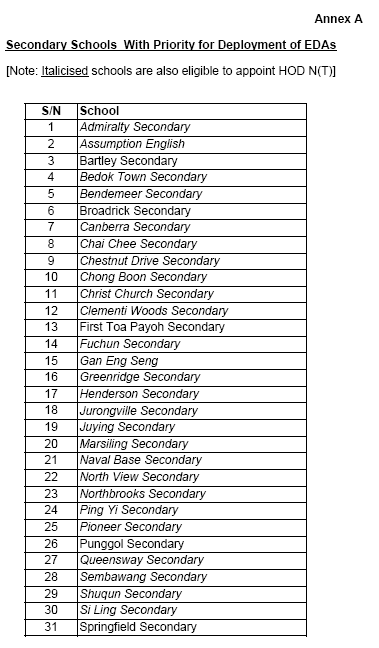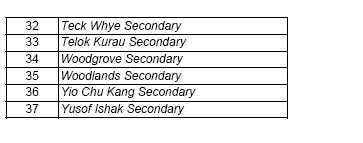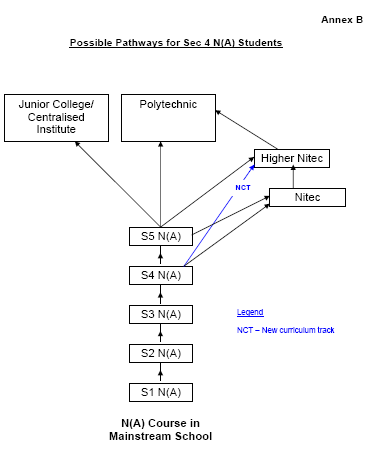|
Continued from
FrontPage of Article
ENHANCING N(A):
STRONGER FOUNDATIONS FOR POST SECONDARY EDUCATION
(A) Refinement
of Promotion Criteria to Sec 5N for better alignment with
Polytechnic Admission Criteria
To better prepare
students for progression to post-secondary education, MOE will
better align the promotion criteria for N(A) students’ promotion
from Sec 4N to Sec 5N with the admission requirements to the
polytechnics.
Currently, the criteria
for promoting the N(A) students to Sec 5N comprise a pass in
English Language (EL) and the aggregate score of their
best 3 subjects at the ‘N’ level examinations. MOE will
introduce the following refinements:
(a) Include both EL and
Mathematics as compulsory subjects for computation in the aggregate
score; and
(b) Increase the number
of subjects to be included in the aggregate score to 5.
The changes will align
the promotion criteria with the admission requirements to the
polytechnics which likewise include 5 subjects in the computation of
the aggregate score. EL and Mathematics are also required for most
of the polytechnic courses. The refined promotion criteria will
apply to the 2009 Sec 4N(A) cohort onwards. Please refer to the
table below.
Current Promotion Criteria
|
Refined Promotion Criteria (from
2009 Sec 4N(A) cohort)
|
-
B3
≤ 10 (B3 refers to the
aggregate score of the best 3 subjects at the ‘N’ level
examinations)
|
-
EL-Maths-B3
≤ 19 (EL-Maths-B3
refers to the aggregate score
of English Language, Mathematics and best 3 subjects at the
‘N’ level examinations)
|
Currently,
78% of Sec 4N students go on to Sec 5N after sitting for their ‘N’
levels. However, only 60% of Sec 5N students do well enough at their
‘O’ levels to be eligible for admission to the polytechnics. Hence,
amongst the Sec 4N cohort, slightly less than half (48%) are
eventually eligible for the polytechnics. With the refinement in
promotion criteria to Sec 5N, MOE anticipates that more students
will be motivated earlier in their secondary years, before they
enter Sec 5N, in their studies aimed at progressing to the
polytechnics.
(B) An Additional Pathway for Sec 4N(A) Graduates to ITE
Students who
do well enough in their ‘N’ levels to meet the revised criteria for
progression to Sec 5N (EL-Maths-B3 ≤ 19) will be given the
additional option of enrolling in a new curriculum track comprising
direct entry to Higher Nitec courses at the ITE. With this option,
the students can start their Higher Nitec studies a year earlier,
compared to the current situation where N(A) students have to sit
for their ‘O’ level examinations first before being eligible for
Higher Nitec courses. Annex B illustrates the possible
pathways for Sec 4 N(A) students.
The ITE will
pilot the new curriculum track starting from 2008, for qualifying
students from the 2007 Sec 4 N(A) cohort.
N(A) students
admitted into the new curriculum track will go through a ten-week
preparatory course. This will comprise relevant topics focussing on
mathematical concepts and scientific principles required for the
Higher Nitec curriculum. Oral and written communication skills will
also be emphasised in the preparatory course to strengthen students’
literary skills.
(C) Sec 4N(A) Students Allowed to Offer More than Two ‘O’
level Subjects
Since 2004,
N(A) students have been allowed to offer up to two ‘O’ level
subjects at Sec 4N(A), when they also sit for their ‘N’ level
examinations. These ‘O’ level subjects are in addition to the ‘N’
level subjects they are already taking.
The cap of
two ‘O’ level subjects was aimed at ensuring that N(A) students
could cope well with both their ‘N’ level and ‘O’ level subjects.
Over the past 3 years, 90% of the Sec 4N(A) students who took ‘O’
level subjects passed the examinations, with over 25% of these
students scoring distinctions.
Starting with
the 2009 Sec 4N(A) cohort, MOE will lift the cap on the number of
‘O’ level subjects N(A) students can offer at Sec 4N(A). Schools
will continue to have the flexibility and discretion in assessing
the suitability of students to take up these options and the number
of ‘O’ level subjects these students can offer.
In addition,
schools are also encouraged to adopt a more customised approach
towards the teaching of N(A) students, by allowing students who are
strong in specific subjects to offer these subjects at the Express
Course level from Sec 1 onwards. This will allow students to be
stretched in their areas of strengths, and will better prepare them
for post-secondary education.
BRINGING NEW APPROACHES INTO N(T)
(A) N(T) Mark II Schools
In recent
years, several initiatives have been introduced to better engage the
N(T) students who prefer a more practice-oriented approach towards
learning. Schools have been customising their programmes and
developing new practices to enhance the quality of learning and
engagement for their N(T) students.
To further
develop excellence in teaching N(T) students, Bedok Town
Secondary, Shuqun Secondary and Si
Ling Secondary will pilot new variants of the N(T)
programme that build on their existing efforts. These “N(T) Mark II”
schools will partner ITE and be supported by MOE to develop their
own curricular offerings and programmes. The collaboration will
involve the following initiatives:
a. The
three schools will offer new N(T) subjects which have greater
emphasis on practice-based learning. The new subjects will be
piloted in the three schools at Sec 3 from 2009 onwards. Unlike
current elective modules, the new subjects will also be reflected in
the students’ GCE ‘N’ level Examination Certificates and be
recognised for admission into the ITE. The new N(T) subjects being
explored include Mechatronics & Robotics, Electrical Technology &
Applications, Computer Networking, as well as Business and Health
Science.
b. The
schools will also offer a larger number and variety of Elective
Modules. Some of these modules could eventually be developed to form
new N(T)-level subjects.
c. The
schools will allow their students to take a mix of the new N(T)
subjects and existing subjects. For instance, students could offer
three existing N(T) subjects (such as the core subjects of English
Language, Mathematics and Mother Tongue Language), and two of the
new N(T) subjects.
d. In
collaboration with the ITE, the schools will further customise the
teaching of existing N(T) subjects, such as Mathematics, to bring
about a greater focus on practice-oriented skills and approaches.
e.
Students will be given opportunity to do industrial attachments and
internships, as an integral part of the schools’ N(T) programmes.
They will also have attachment opportunities in ITE.
(B)
Secondment of ITE Lecturers to Secondary Schools
To promote
the cross-fertilisation of ideas and teaching strategies, MOE will
pilot a scheme in 2008 to second ITE lecturers[3] to the three N(T)
Mark II schools.
These
seconded ITE lecturers will be deployed to teach the new N(T)
subjects. In addition, they will work with the teachers to customise
the existing N(T) subjects and develop practice-oriented enrichment
programmes that will enrich the schooling experiences of the N(T)
students. The ITE lecturers would also have industrial experiences
and networks that the schools can tap on.



Source:
www.moe.gov.sg Press Release 2
October 2007

|